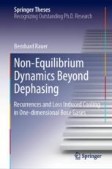Search
Search Results
-
On Krylov complexity in open systems: an approach via bi-Lanczos algorithm
Continuing the previous initiatives [
1 ,2 ], we pursue the exploration of operator growth and Krylov complexity in dissipative open quantum systems.... -
Decoherence and Landauer’s principle in qubit-cavity quantum-field-theory interaction
We consider quantum decoherence and Landauer’s principle in qubit-cavity quantum field theory (QFT) interaction, treating the qubit as the system and...

-
Billiards, Conservative Systems and Ergodicity
Dynamical billiards are a subclass of conservative dynamical systems, which are paradigmatic because they are simple, familiar with everyday life,...
-
Information and Quantum Mechanics
Working out a detailed picture in Chaps. 5 to 7 how...
-
Quantum many-body scars and weak breaking of ergodicity
Thermalization is the inevitable fate of many complex quantum systems, whose dynamics allow them to fully explore the vast configuration space...

-
50 Years of quantum chromodynamics
Quantum Chromodynamics, the theory of quarks and gluons, whose interactions can be described by a local SU(3) gauge symmetry with charges called...
-
Strong Dynamical Trap**s Originating Ergodicity Breaking in Coupled Hamiltonian Systems
Ergodicity breaking has a profound effect on the transport of particles in typical nonlinear Hamiltonian systems. In this paper, we analyze the...

-
Room-temperature superfluorescence in hybrid perovskites and its origins
The formation of coherent macroscopic states and the manipulation of their entanglement using external stimuli are essential for emerging quantum...

-
Recurrences
Each finite and isolated physical system undergoing dynamics will return arbitrarily close to its initial configuration after a certain amount of...
-
Out-of-horizon correlations following a quench in a relativistic quantum field theory
One of the manifestations of relativistic invariance in non-equilibrium quantum field theory is the “horizon effect” a.k.a. light-cone spreading of...
-
Some Models of “Quantum Measurement”
In this chapter, we shall describe several specific models of “small” quantum mechanical systems interacting with (“measured by”) the “large” quantal...
-
Extremal chaos
In maximally chaotic quantum systems, a class of out-of-time-order correlators (OTOCs) saturate the Maldacena-Shenker-Stanford (MSS) bound on chaos....
-
Approach to Equilibrium
We give Boltzmann’s explanation of the convergence a non-equilibrium state to an equilibrium one. Since we consider isolated systems, the initial...
-
Complex Network Approach to Thermoacoustic Systems
In the previous chapters, we discussed the phenomenon of the onset of thermoacoustic instability in turbulent combustors. In such systems, the...
-
Subleading bounds on chaos
Chaos, in quantum systems, can be diagnosed by certain out-of-time-order correlators (OTOCs) that obey the chaos bound of Maldacena, Shenker, and...
-
Fluctuations, Noise, and Microscopic Degrees of Freedom
The foregoing sections presented two almost antithetic views of the way physical systems organize the flow of information: In the myopic picture...
-
A tale of two saddles
We find a new on-shell replica wormhole in a computation of the generating functional of JT gravity coupled to matter. We show that this saddle has...
-
Non-Equilibrium Dynamics Beyond Dephasing Recurrences and Loss Induced Cooling in One-dimensional Bose Gases
Cold atomic gases trapped and manipulated on atom chips allow the realization of seminal one-dimensional (1d) quantum many-body problems in an...
-
Intermittency—A State That Precedes Thermoacoustic Instability and Blowout in Turbulent Combustors
Let us recall from Chaps. 3 and 4 that during the onset of...
-
Complexity growth in integrable and chaotic models
We use the SYK family of models with N Majorana fermions to study the complexity of time evolution, formulated as the shortest geodesic length on the...
